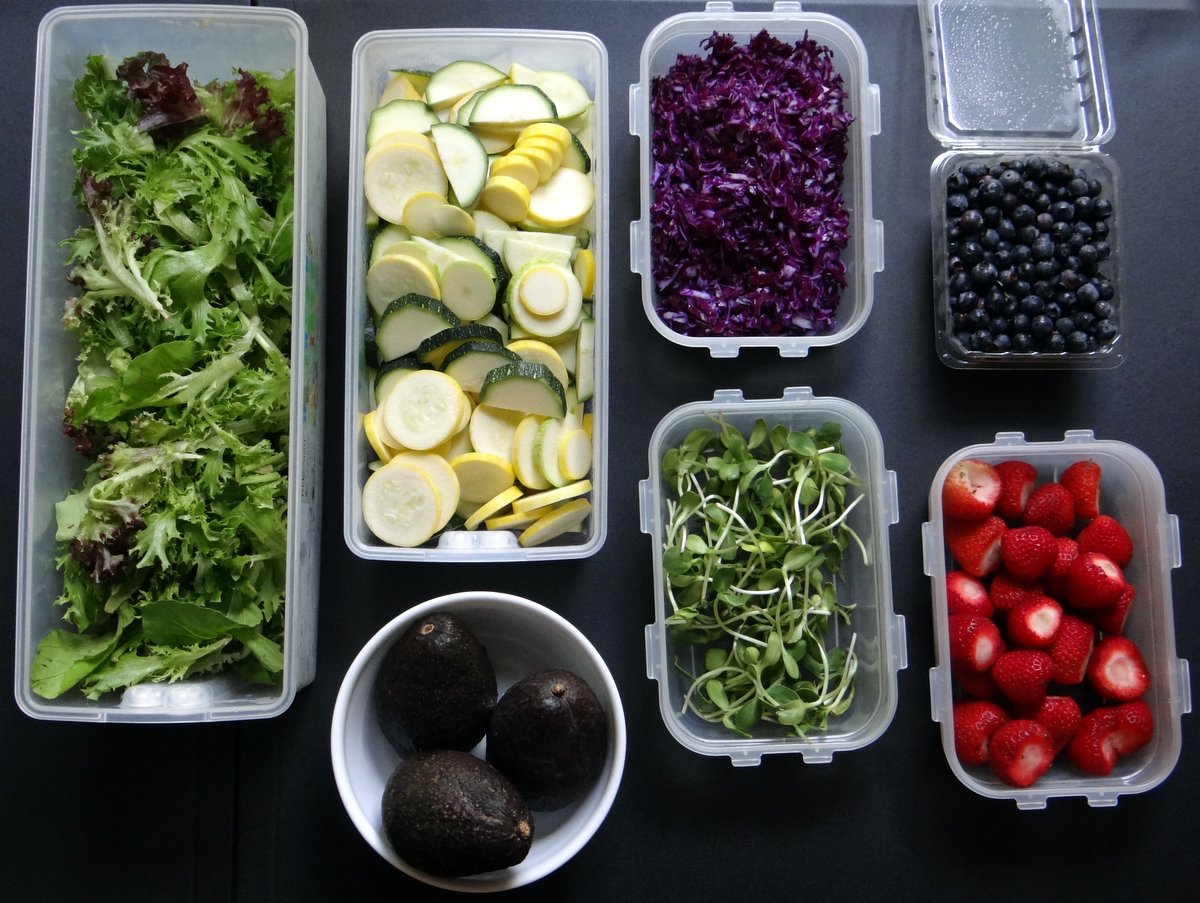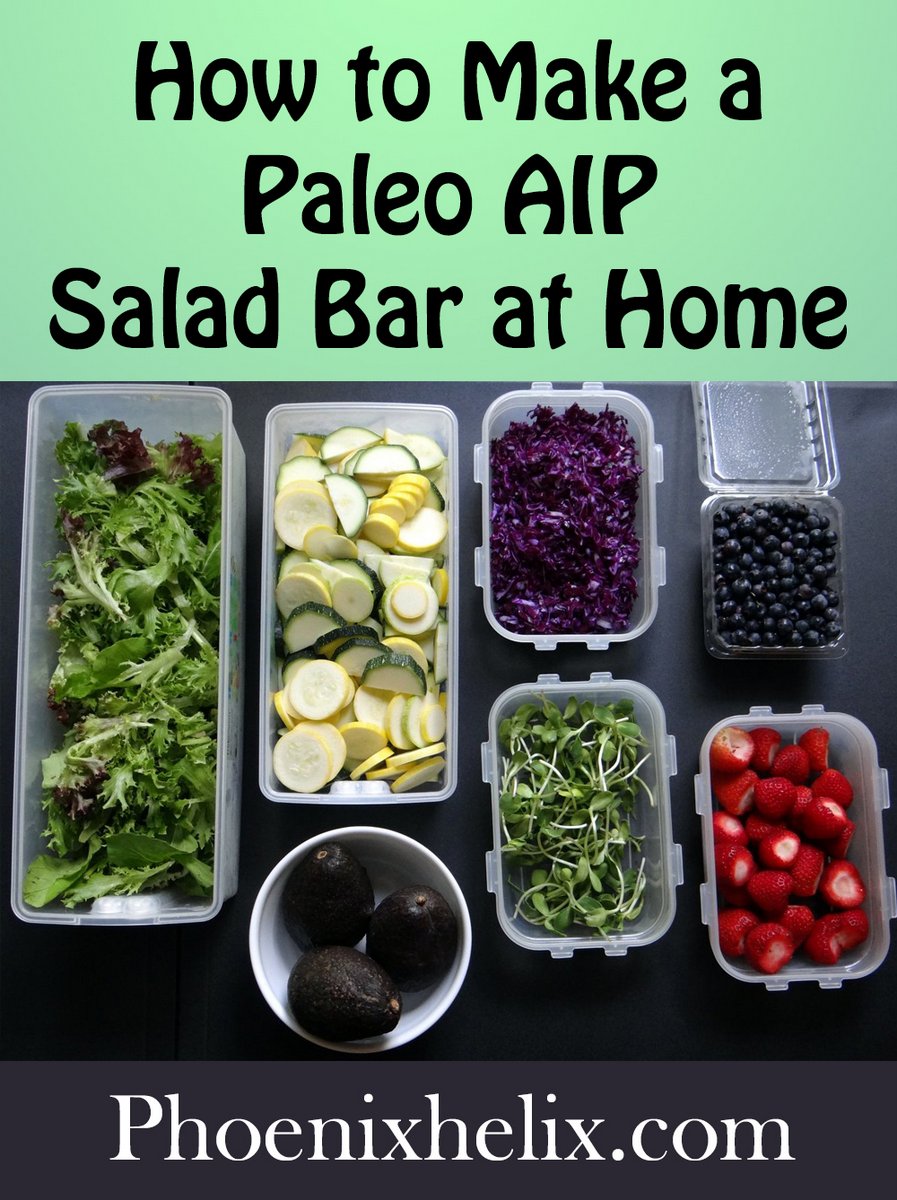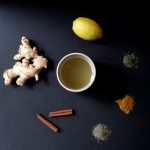
“My daily ‘big-ass salad’ has been my lunch of choice for a couple of decades at least, and I don’t see that ever changing. I eat from a large mixing bowl to keep everything from spilling over. A plate just won’t hold all this great stuff in. In fact, when visitors see my salad, they assume I’ve made enough for several people. Nope. All mine.”
~ Mark Sisson
Making Good Nutrition Easy
Vegetables are the foundation of the Paleo AIP Food Pyramid. The recommendation is to eat 6-14 cups daily. How is that possible? Here’s a good article with lots of tips, but having a big salad every day is a great headstart.
Another key to success on the AIP is making it sustainable, and that means making it as easy as possible. No one wants to be chopping vegetables for every meal. One of my favorite kitchen hacks came from Mark Sisson (quoted above). I chop my salad veggies in advance for quick lunches all week.
Keeping Produce Fresh
One common question is how to keep produce fresh in the fridge – whether it’s whole or chopped. Many of us know how bad it feels to throw vegetables away that have gone bad before we have a chance to eat them. Chopping them in advance makes them easier to add to a meal, so this is less likely to happen. If you’re able to buy your produce at your local farmer’s market, it’s more freshly picked than what you find in a store, so that’s helpful, too. But no matter where you buy it, there are ways to extend its life in your fridge:
1. Storage Containers
I am not a Tupperware salesperson, but my stepdaughter gave me Fridgesmart containers over 20 years ago, and they have been life-changing for me. They keep produce fresh easily twice as long as most other containers. This is because they have a ridged bottom that allows air circulation to prevent sogginess. They also have vents in the side, and depending on the vegetable, you leave these vents open, closed, or half-open. If you can afford these, I highly recommend them. I have a few sets of this version. They also sell a newer design that works just as well. If you cannot afford them, no worries. Some vegetables do fine in any airtight container, and for the ones that need to breathe, you can wrap them in paper towels and store them in a bag instead of a covered container.
2. Which Need Airtight Containers?
Asparagus, Beets, Carrots, Celery, Cucumbers, Radishes, Salad Turnips, Summer Squash, and Zucchini.
3. Which Need to Breathe?
Arugula, Bok Choy, Broccoli, Cabbage, Cauliflower, Chard, Collards, Endive, Kale, Lettuce, Radicchio, Scallions, Spinach, and other Greens.
4. Which Can You Chop in Advance?
Most of them! Instead of listing all the ones you can chop in advance, I’ll list below the few that you can’t. One note: part of preparing vegetables is washing them, but be sure you dry them as well. They don’t have to be perfectly dry (with greens that’s almost impossible). But you do want them to be mostly dry in order to maximize their life span in your fridge.
5. Which Are Best Chopped Right Before Eating?
Vegetables with a high moisture content are best chopped right before eating. Otherwise they get soggy. Cucumber is one example of this. Most fruit falls into this category, too. However, sometimes you can do a partial prep to save time. For cucumbers, wash and dry them, slice off the ends, and put them in an airtight container. Then, all you have to do for your salad is slice off a few pieces. For strawberries, wash and dry them, remove the stems, and store them in an airtight container as well. And while strawberry stems are too tough to enjoy in a salad, they are edible and nutritious. Store them in the freezer and add some to your next smoothie. Lastly, avocado tends to brown shortly after being exposed to the air. I do sometimes save half an avocado for the next day. To minimize browning, I press it flesh-side down onto a small, flat plate and set it in the fridge. It will still brown a little bit, but not as much. The good news is that the brown color doesn’t mean the avocado has gone bad – it’s still nutritious. It just doesn’t look as pretty.
6. What About Grated Vegetables?
These don’t keep as long – usually no more than a few days, but they can still be a really nice addition to your salad. Some of my favorite vegetables to grate are beets, cabbage, carrots, and daikon radish. Grate just three days worth at a time, and store them in an airtight container.
7. Mushrooms: a Special Case
Mushrooms are one of the foods Dr. Sarah Ballantyne calls superfoods for the gut microbiome, so they’re wonderful to add to your salads. They keep best when stored in a paper bag in the refrigerator.
8. What About Herbs?
If you have an herb garden, cutting them fresh for your salad is easy. But if you have to buy them from a store, there are tricks to keeping them fresh longer. Herbs fall into two categories: soft-stemmed and hard-stemmed. For herbs with soft stems, treat them like a fresh bouquet of flowers. Trim the ends and stand them up in a glass of water. Basil likes to be kept at room temperature (it blackens in the fridge). Other soft herbs like cilantro and parsley should be refrigerated in a glass of water and covered loosely with a plastic bag. For herbs with hard stems, like rosemary and thyme, wrap them in a damp paper towel and store them in an airtight container.
9. Pickled and Fermented Veggies
Fermented vegetables are highly recommended on a healing diet due to their beneficial bacteria. Try adding a little sauerkraut or kimchi to your salad. Pickled vegetables don’t contain a probiotic boost, but they do provide a flavor boost. Some of my favorites are refrigerator pickles, pickled red onions, and pickled beets.
10. Are Sprouts AIP?
You may notice sprouts in the photo at the top of the post. Those are sunflower sprouts, and they’re my favorite. Since they come from seeds, you may wonder if they’re allowed on the paleo autoimmune protocol. As long as you don’t eat the seeds, it’s fine. Broccoli sprouts and radish sprouts are also AIP-friendly, so long as you don’t eat the seeds. Legume sprouts are the ones that are eliminated on the AIP (alfalfa sprouts, mung bean sprouts, red clover sprouts, etc.). This is because the lectins from the beans are also concentrated in the sprouts. You can test these during reintroductions, but skip them during the elimination phase. What’s the best way to store sprouts? Sunflower sprouts are pretty hardy – you can put those directly in an airtight container. For broccoli sprouts, wrap them in a paper towel before storing in an airtight container.
What About Optimal Nutrition?
What’s more nutritious? Vegetables that have been chopped in advance, or ones chopped at the last minute? There’s been a lot of research in this area, and it turns out that some nutrients actually increase (antioxidants and polyphenols) while others may decrease (vitamin C). But there’s not a major change in either direction. Here’s the most important thing to remember: the most nutritious vegetables are the ones you eat! What’s the easiest way to ensure you’ll eat more vegetables?
Easy Salad Dressings
I’ve always preferred simple dressings – just a drizzle of extra-virgin-olive oil along with a drizzle of vinegar. Both oils and vinegars come in a wide variety of flavors, which keeps me from getting bored. Right now, I’m loving orange-infused EVOO with balsamic vinegar. But if you want something fancier, here are 10 delicious AIP salad dressing recipes. Choose one to make in advance, and it should keep in the fridge for a week.
- No Frills Salad Dressing from Joanna Frankham
- Anti-inflammatory Turmeric Dressing from Unbound Wellness
- Ranch Dressing from Wendi’s AIP Kitchen
- Avocado Caesar Dressing from The Honest Spoonful
- Roasted Garlic Greek Dressing from Lichen Paleo Loving AIP
- Teriyaki Dressing from Cook 2 Nourish
- Blueberry-Basil Dressing from Salads with Anastasia
- Homemade Italian Dressing from Don’t Eat the Spatula
- Cinnamon Orange Dressing from Food Courage
- Cilantro Lime Dressing from Pure and Simple Nourishment
Easy Proteins
If you’re making this a meal, be sure to include some protein. Canned or pouched seafood keep well in the pantry, and they’re also filled with anti-inflammatory, omega-3 fatty acids. ShopAIP sells a wide variety. Leftover meat or seafood from last night’s dinner is also great to throw into a salad. Or you can cook some protein specifically for your salads, keeping it in the fridge to grab throughout the week. Here are some simple recipes for salmon, chicken, pork, and beef.
You May Also Be Interested In










Thank you so much ☺️ I’ve recently just found out I’ve got a couple of autoimmune things going on, one being lupus, and for a while before I found this out I’ve been having issues with the nightshade family, suffering major flare ups every time I eat the foods my family has been eating for generations. This lovely list of recipes is wonderful and when i stumbled across your salad builder page, you just made my year! I can have tasty fresh salads with some form of a refreshing feel and with some nice taste I’ve been a little worried about my future in food, and this is after doing a celiac cut and gluten cut and having lost a LOT of weight with an overactive thyroid, only to still be inflamed from the potato powder in everything! So I had no idea what to do food wise until I got diagnosed and looked into it further, and now I’ve found your page I think I might have a chance of finding a diet that’s not to bland and tasteless. Thank you so much for doing this! ✨ you give a girl some hope
Nay, I’m so glad you found this roundup and my website overall. Wishing you wellness on every level! Here’s to hope and finding joy in food again.